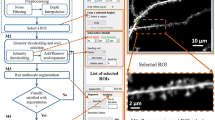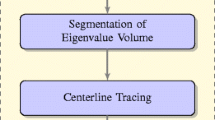Abstract
High-throughput automated fluorescent imaging and screening are important for studying neuronal development, functions, and pathogenesis. An automatic approach of analyzing images acquired in automated fashion, and quantifying dendritic characteristics is critical for making such screens high-throughput. However, automatic and effective algorithms and tools, especially for the images of mature mammalian neurons with complex arbors, have been lacking. Here, we present algorithms and a tool for quantifying dendritic length that is fundamental for analyzing growth of neuronal network. We employ a divide-and-conquer framework that tackles the challenges of high-throughput images of neurons and enables the integration of multiple automatic algorithms. Within this framework, we developed algorithms that adapt to local properties to detect faint branches. We also developed a path search that can preserve the curvature change to accurately measure dendritic length with arbor branches and turns. In addition, we proposed an ensemble strategy of three estimation algorithms to further improve the overall efficacy. We tested our tool on images for cultured mouse hippocampal neurons immunostained with a dendritic marker for high-throughput screen. Results demonstrate the effectiveness of our proposed method when comparing the accuracy with previous methods. The software has been implemented as an ImageJ plugin and available for use.









Similar content being viewed by others
References
Al-Ali, H., Blackmore, M., Bixby, J. L., & Lemmon, V. P. (2013). High content screening with primary neurons. In Assay Guidance Manual. Bethesda: Eli Lilly & Company and the National Center for Advancing Translational Sciences.
Al-Kofahi, K. A., Lasek, S., Szarowski, D. H., Pace, C. J., Nagy, G., Turner, J. N., et al. (2002). Rapid automated three-dimensional tracing of neurons from confocal image stacks. IEEE Transactions on Information Technology in Biomedicine, 6(2), 171–187.
Becker, L., Armstrong, D., & Chan, F. (1986). Dendritic atrophy in children with Down’s syndrome. Annals of Neurology, 10(10), 981–991.
Brewer, G. J., & Cotman, C. W. (1989). Survival and growth of hippocampal neurons in defined medium at low density: advantages of a sandwich culture technique or low oxygen. Brain Research, 494, 65–74.
Can, A., Shen, H., Turner, J. N., Tanenbaum, H. L., & Roysam, B. (1999). Rapid automated tracing and feature extraction from retinal fundus images. IEEE Transactions on Information Technology in Biomedicine, 3(2), 125–138.
Dijkstra, E. W. (1959). A note on two problems in connexion with graphs. Numerische Mathematik, 1, 269–271.
Dunkle, R. (2003). Role of image informatics in accelerating drug discovery and development. Drug Discovery World, 5, 75–82.
Faherty, C. J., Kerley, D., & Smeyne, R. J. (2003). A Golgi-Cox morphological analysis of neuronal changes induced by environmental enrichment. Developmental Brain Research, 141, 55–61.
Fox, S. (2003). Accommodating Cells in HTS. Drug Discovery World, 5, 21–30.
Fredman, M. L., & Tarjan, R. E. (1987). Fibonacci heaps and their uses in improved network optimization algorithms. Journal of the Association for Computing Machinery, 34(3), 596–615.
Glausier, J., & Lewis, D. (2013). Dendritic spine pathology in schizophrenia. Neuroscience, 251, 90–107.
Hawker, C. D. (2007). Laboratory automation: total and subtotal. Laboratory Management, 27(4), 749–770.
Liu, Y. (2011). The DIADEM and beyond. Neuroinformatics, 99–102.
Meijering, E. (2010). Neuron tracing in perspective. Cytometry. Part A, 77(7), 693–704.
Meijering, E., Jacob, M., Sarria, J., Steiner, P., Hirling, H., & Unser, M. (2004). Design and validation of a tool for neurite tracing and analysis in fluorescence microscopy images. Cytometry. Part A, 58(2), 167–176.
Myatt, D. R., Hadlington, T., Ascoli, G. A., & Nasuto, S. J. (2012). Neuromantic - from semi-manual to semi-automatic reconstruction of neuron morphology. Frontiers in Neuroinformatics, 6, 4.
Narro, M. L., Yang, F., Kraft, R., Wenk, C., Efrat, A., & Restifo, L. L. (2007). NeuronMetrics: Software for semi-automated processing of cultured neuron images. Brain Research, 113b, 57–7 5.
Nieland, T. J., Logan, D. J., Saulnier, J., Lam, D., Johnson, C., Root, D. E., et al. (2014). High content image analysis identifies novel regulators of synaptogenesis in a high-throughput RNAi screen of primary neurons. PLoS ONE, 9(3), e91744.
Otsu, N. (1975). A threshold selection method from gray-level histograms. IEEE Transactions on Systems, Man, and Cybernetics, 9(1), 62–66.
Patt, S., Gertz, H., Gerhard, L., & Cervós-Navarro, J. (1991). Pathological changes in dendrites of substantia nigra neurons in Parkinson’s disease: a Golgi study. Histology and Histopathology, 6(3), 373–380.
Peng, H., Long, F., Zhao, T., & Myers, E. (2011). Proof-editing is The Bottleneck of 3D Neuron Reconstruction: The Problem and Solutions. Neuroinformatics.
Peng, H., Ruan, Z., Long, F., Simpson, J. H., & Myers, E. W. (2010). V3D enables real-time 3D visualization and quantitative analysis of large-scale biological image data sets. Nature Biotechnology, 28(4), 348–353.
Pittenger, C., & Duman, R. S. (2008). Stress, depression, and neuroplasticity: a convergence. Neuropsychopharmacology Reviews, 33, 88–109.
Pool, M., Thiemann, J., Bar-Or, A., & Fournier, A. E. (2008). NeuriteTracer: a novel imagej plugin for automated. Journal of Neuroscience Methods, 168(1), 134–139.
Rodriguez, A., Ehlenberger, D., Hof, P., & Wearne, S. (2006). Rayburst sampling, an algorithm for automated three-dimensional shape analysis from laser scanning microscopy images. Nature Protocol, 1(4), 2152–61.
Rønn, L. C., Ralets, I., Hartz, B. P., Bech, M., Berezin, A., Berezin, V., et al. (2000). A simple procedure for quantification of neurite outgrowth based on stereological principles. Journal of Neuroscience Methods, 100(1), 25–32.
Sharma, K., Choi, S.-Y., Zhang, Y., Nieland, T. J., Long, S., Li, M., et al. (2013). High-throughput genetic screen for synaptogenic factors: identification of LRP6 as critical for excitatory synapse development. Cell Reports, 5(5), 1330–41.
Sternberg, S. R. (1983). Biomedical Image Processing. IEEE Computer, 22–34.
Vallotton, P., Lagerstrom, R., Sun, C., Buckley, M., Wang, D., Silva, M. D., et al. (2007). Automated analysis of neurite branching in cultured cortical neurons using HCA-Vision. Cytometry. Part A, 71A, 889–895.
Wilkinson, M. H. (1998). Segmentation techniques in image analysis of Microbes. In Digital image analysis of microbes: Imaging, morphometry, fluorometry and motility techniques and applications (pp. 135–170). Chichester: John Wiley & Sons.
Wu, C., Schulte, J., Sepp, K. J., Littleton, J. T., & Hong, P. (2010). Automatic robust neurite detection and morphological analysis of neuronal cell cultures in high-content screening. Neuroinformatics, 8(2), 83–100.
Zhang, Y., Zhou, X., Alexei, D., Marta, L., Adjeroh, D., Yuan, J., et al. (2007). Automated neurite extraction using dynamic programming for high-throughput screening of neuron-based assays. NeuroImage, 35(4), 1502–1515.
Zuiderveld, K. (1994). Contrast limited adaptive histogram equalization. In Graphics Gems IV (pp. 474–485). Princeton: Academic Press.
Acknowledgments
We thank Dr. Hisashi Umemori, Dr. Asim Beg and Dr. Jun Zhang for their comments on the project. We thank Venkata Wunnava, Sowmya Ganugapati and Joseph Steinke who provided their help at the different stages. The project is supported by NIH R15 MH099569 (Zhou), NIH R01MH091186 (Ye), NIH R21AA021204 (Ye), and Protein Folding Disease Initiative of the University of Michigan (Ye).
Conflict of Interest
None declared.
Author information
Authors and Affiliations
Corresponding author
Rights and permissions
About this article
Cite this article
Smafield, T., Pasupuleti, V., Sharma, K. et al. Automatic Dendritic Length Quantification for High Throughput Screening of Mature Neurons. Neuroinform 13, 443–458 (2015). https://doi.org/10.1007/s12021-015-9267-4
Published:
Issue Date:
DOI: https://doi.org/10.1007/s12021-015-9267-4




